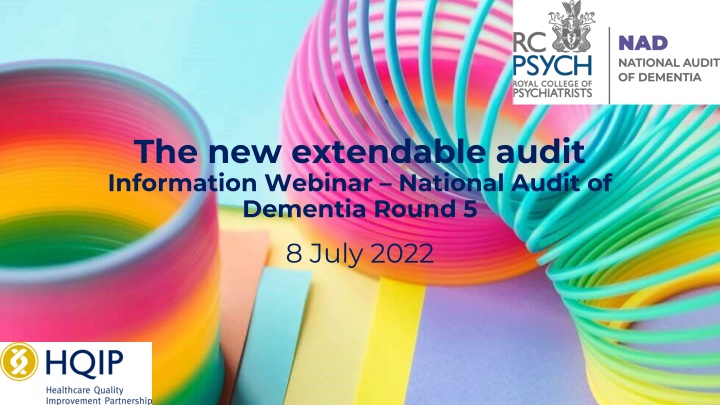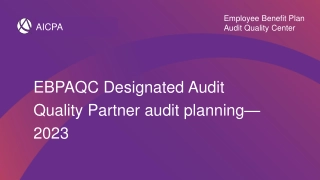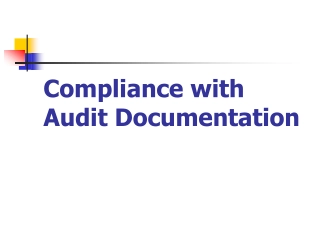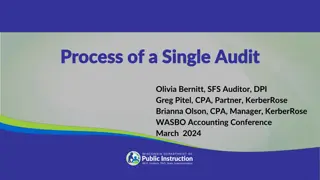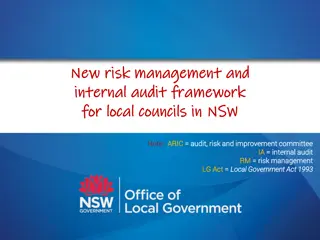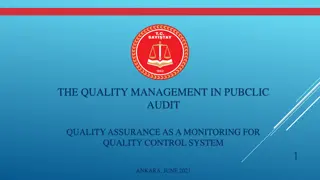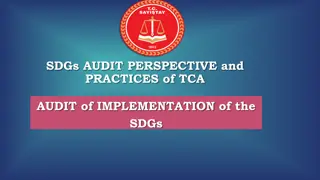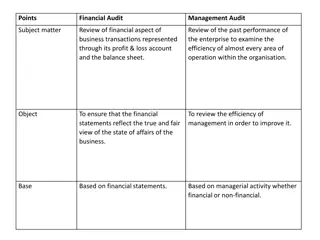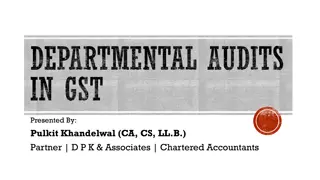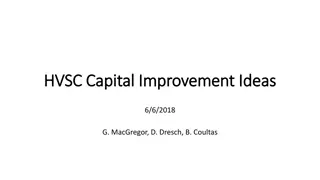The new extendable audit
The upcoming National Audit of Dementia Round 5 webinar scheduled for July 8, 2022. Delve into the agenda, housekeeping details, and insights into the next round of audits in general hospitals. Learn about the pilot changes being implemented for a greater quality improvement focus and more timely reporting. Discover the key aims, prospective identification methods, and the importance of a collaborative team effort. Stay updated on the latest developments in dementia care audits.
Download Presentation

Please find below an Image/Link to download the presentation.
The content on the website is provided AS IS for your information and personal use only. It may not be sold, licensed, or shared on other websites without obtaining consent from the author.If you encounter any issues during the download, it is possible that the publisher has removed the file from their server.
You are allowed to download the files provided on this website for personal or commercial use, subject to the condition that they are used lawfully. All files are the property of their respective owners.
The content on the website is provided AS IS for your information and personal use only. It may not be sold, licensed, or shared on other websites without obtaining consent from the author.
E N D
Presentation Transcript
The new extendable audit Information Webinar National Audit of Dementia Round 5 8 July 2022
Agenda i. Welcome and Housekeeping 11.00 ii. National Audit of Dementia R5 pilot/ casenote audit 11.05 iii. Pilot site perspectives 11.35 iv. Q and A/ discussion 11.40 v. ADS, patient and carer feedback, timeline 11.55 vi. Q and A 12.05 vii. Close 12.15
Housekeeping Please use the Chat function to comment and ask questions throughout the presentation, we will be monitoring this throughout If you are not speaking please mute your microphone During the question sessions please use the raise hand function (Participants > raise hand) We will note any questions not answered today and get back to you via email please identify yourself and hospital in the Chat so we can do this. This session will be recorded to capture discussions and feedback. Presentations will be shared
Next Round of Audit in general hospitals: Content summary Prospective identification of patients with dementia (total sample) New patient-level audit measures (reduced data set focussing on key measures) Annual Dementia Statement (key organisational information building into a series of statements about the hospital s approach to care) Patient feedback (collected using a newly developed flexible tool, based on feedback from people with dementia about care experience and question format) Carer questionnaire As in previous rounds, this is not a one person job The Dementia Lead/ Team will need high level support from Chief Nurse/ MO and from colleagues to assist: Informatics department, administrative staff, junior doctors, ward managers, Patient and Public Engagement leads
Piloting changes to the audit In 4 previous rounds of NAD, patient notes sampling was done using ICD10 codes These are applied post discharge, which can take 1-3 months, and sometimes longer Leads to significant time lag between patient admission and receiving any reporting Key aim for next round of audit is a greater QI focus More frequent and timely reporting Rapid feedback of performance to identify and address issues outside of formal reporting Better integration with QI techniques and ability to evaluate their effectiveness throughout the audit 2-part pilot: Prospective ID is this possible? Multiple methods are in use. What sort of sample do you get? Curtailed and focused data set, new data platform Working with 20 sites
Pilot sites Pilot sites for main data collection phase Given NAD many hours of their time to pilot and provide feedback Aintree University Hospital Medway Maritime Hospital Milton Keynes University Hospital Peterborough City Hospital Pinderfields hospital Queens Hospital Burton Royal Liverpool University Hospital Sunderland Royal Hospital The Alexandra Hospital Whiston Hospital Ysbyty Gwynedd Bedford Hospital Bradford Teaching Hospital Chesterfield Royal Hospital East Surrey Hospital Gloucestershire Royal Hospital Kingston Hospital St James's University Hospital Macclesfield District General Maidstone Hospital
How did they get on? 2 groups of volunteers 2 debriefing webinars Aggregation of anonymous feedback 1 webinar to discuss recommendations
The challenges The timing 1. Identifying eligible patients 2. Record keeping systems 3. Data items 4. Specialist input 5. Sample size 6. Real-time measurement
1. Identifying eligible patients People with dementia are not immediately identified as such on their admission to hospital. Case finding therefore has additional requirements to those in many other audits, where the diagnosis or the treatment pathway identifies patients for audit. These can include: electronic flagging, based on known diagnosis/ previous admission; history taken at admission; referral to a team once admitted; assessment criteria applied to all in a certain age group or designated frail ; review of records of medications or consultations with other services e.g. CMHTs, GPs, memory services; discussions with families and carers.
1. Identifying eligible patients Many dementia leads were limited in the patients they were able to include in audit by the capacity of their record keeping systems. Examples were: Access to notes: patients with shorter admission (less than 72 hours) may already have been discharged and their records not accessible i.e. they may with them, or they may have been removed for data inputting, sometimes offsite. Content of notes: some (but not all) systems had the capability to also identify patients with cognitive impairment (possible dementia, delirium); Access to lists: some systems produced a daily record from admissions of patients known to have dementia, but these are not retained to the next day.
1. Identifying eligible patients: quotes from pilot participants Timeliness Sometimes the nurses weren't screening in a timely manner... and sometimes the information provided to them from the care homes wasn't always correct. Is this an underline dementia or a delirium? ... It is not really possible to establish until end of the stay as to what is their cognition. Systemic issues Problems inputting the data mainly because we have a completely new IT system and all our notes have now gone electronic from completely paper based... hard to identify patients we are going through the exercise as a trust of marking patients with dementia .
1. Identifying eligible patients: quotes from pilot participants Accuracy of lists 19 patients were coded... we found 39 . I'd say 70% were correct and then I found the other 30%. But on the plus side The problem for me is the actual IT system from this end. I think once it is up and running we can identify patients with dementia quicker and hopefully patients with delirium or confusion stop. I think it'll be quite a straightforward process with system you have given us. It is just everybody s systems are so different and that's what makes it difficult at the moment. So hopefully we all go electronic, it will be a smoother process. It's not all negative! We ve gone away and worked with our teams to say how we can develop our reports so they are more sophisticated and it is less burdensome... one of the benefits of taking part in this pilot.
2. Record keeping systems Electronic systems can support and facilitate identification but not all hospitals have a system with this capability in place or are close to developing one. Electronic records may not always contain the ability to flag patients with dementia for identification. Of the participating sites, 5 had fully (or almost) electronic records, 2 were paper based and the rest mixed.
3. Data items As patients with dementia will be found across adult wards and treatment pathways, their records may be in different parts of the system and presented differently. e.g. one department may use NEWS2, incorporating 4AT delirium screen, where another may use 4AT alone or a different screening. This means clinical judgement must be involved in checking the audit criteria for each patient. As length of stay is a key metric, additional time was required in order to complete each record after discharge. The majority of sites could not access consistent administrative support to assist with this. Time taken to find patients and enter the data was generally sizeable.
3. Data items Case finding (minutes per pt) all pilots Range 5-45 Electronic records Mixed Dementia information on system Dementia information not on system Paper Range 5-40 Range 10-40 Range 5-25 Range 20-40 45 Data collection following case finding varied - shortest time with electronic system/ flagging and or the support of the informatics department. Extra time could be taken to find missing data and cross check eligibility
Record keeping systems and data items: quotes from pilot participants Timeliness If we had had to track paper notes, that would have been impossible... Week 1, I requested the notes of the 10 patients we had identified. I received one set of notes last week luckily we've got enough information electronically, so we were able to do it. We got what we could, and left we couldn't... it took too long to get data... our coders are working from home which causes a massive delay. I was using hard copies and I was following patients as they went from the admitting ward (I spent) around 10 hours of my time every week going from ward to ward, chasing information, updating information... it was quite time consuming.
4. Specialist input Input from a lead nurse or consultant was required to check data items and also inclusion/exclusion criteria. This was necessary even where a site was supported by an electronic records system for identification. Some of the questions are a bit subjective and require a bit more of a clinical input, whereas the 4AT is a yes or no answer. As a nurse consultant (the only one in the hospital who covers patients with dementia) I am covering a lot of the clinical aspects of care and service development, having the time to input this data... it's almost at the bottom of my list and I don't want it to be... I felt I was doing a role I didn't need to do. It took me away from my own work quite a bit... and I would work overtime.
5. Sample size For all the reasons already discussed, the size of the task being asked of hospitals will relate to the sample required. Some quotes from the pilot sites I always made sure I sent him 20 patients per week... I couldn't have done anymore because I wouldn't have had the time. I was doing that as well as doing my ordinary job. It didn't feel as if it were onerous as long as I was only doing 10 [per week]. Doing the whole lot (50) the first week nearly killed me! We managed to do all the patients... I had junior doctors who helped. (We sampled) around the 300 mark for patients over 70. If we done for 18 plus, I can't imagine how many people that would have taken .
5. Sample size: reflections and suggestions We were ambitious and tried to input everyone, but we ended up doing a quarter - 51 out of 206 . If you want good compliance with any audit going forward, it's better to keep the sample size down. All would be too time consuming: data would be missed; people would cut corners. If it was just a snapshot, you'd get the same qualitative data, but people would be more likely to do it properly. So maybe 25 to 30%, maybe more?
6. Real-time measurement There was consistent support for the added value of screening all patients as a way of ensuring that all eligible patients were identified and then offered appropriate care and supports. Participants expressed mixed feelings about the benefits of real-time measurement as a driver for improving quality: - some spoke enthusiastically about the opportunities to take forward immediate plans for improvements; - others argued that they had previously used their local data in the same way; - some commented on the fact that this way of working had generated more reliable and timely data.
Summary Identifying eligible patients Many different systems are in use to identify people with dementia admitted to the hospital, no one method of identification can be recommended Some but not all systems can identify: people with possible dementia, people under 65 In most cases, prospective ID picks up people with dementia not identified by ICD10 coding Allowing a time lag between admission and identification does not necessarily mean that more patients are identified Supports Support will be required from audit or informatics departments The proportion of people with dementia admitted does not correlate to the size of the hospital and cannot be predicted
Summary But Finding a total sample creates awareness of systems and where people are missed Entering data on a sub sample is sufficient for comparable data and benchmarking Therefore Flexibility should be provided but distinct data collection periods identified for comparability and to allow resource allocation Data collection closer in time to admission supports quicker identification of any issues
The new look audit: extendable with flexibility Has a period of identification of a sample of ALL patients followed by entry of key metrics on a sub sample The yearly sample (80) can be split between 2 data entry periods More patient data can be submitted by larger sites Data can be viewed/ downloaded as submitted Split data set increases case finding and minimises clinical input
Prospective ID will provide us with local and national information about the number of patients with dementia being admitted in a month and will pick up patients missed by coding.
4 weeks allows hospitals with lower admissions to identify requisite number of patients Casenote audit Sampling : Identify all patients admitted with dementia over a 4 week period Inclusion of patients with probable/ suspected dementia No age limit but we know that this will affect some samples Demographic information To be included if possible Dataset: Over the next 8 weeks, enter data on a sample of patients Delirium screening and assessment, pain assessment and repeat, discharge planning Discharge information including length of stay entered after a lag of one month This will allow for the key metric LOS to be completed for nearly all patients. One data entry period is mandatory and one voluntary Autumn phase is mandatory for all sites Sites choosing to do so can split their sample between Autumn and Spring First reporting point will be based on Autumn data
Casenote dataset The dataset has been split into the three parts Can be input by non- clinical staff Part one : Demographics, admitting condition, dementia status/ subtype, admitting ward, place of residence prior. Patients with a confirmed or working diagnosis or with known/ suspected cognitive impairment are eligible Part two: Delirium screening, assessment, management/ care plan Pain assessment and follow up pain assessment Initiation of discharge planning Sequence of questions relating to pain assessment changed so easier to answer/ analyse if a non-standard assessment Part three Date of discharge (or death) Place discharged/ transferred Was the patient on the right ward for responsible consultant specialty Was the patient receiving end of life care Can be submitted by non clinical staff
pilot site feedback
Annual Dementia Statement This is information collected at hospital level The tool is in the form of simple questions which will produce a series of statements which illustrate the approach to the provision of dementia care. Eg In our hospital, 100% of staff working on adult wards have received training in dementia awareness. The hospital is signed up to John s Campaign . Results from the casenote audit will feed in eg: 78% of patients with dementia were screened for delirium . 82% patients with dementia received an assessment for pain . Results from the carer questionnaire will also be added e.g. Carers rated the care delivered highly at 83/100 . The output will be a poster PDF which can be displayed on the website and will be updated yearly
Patient feedback tool We asked people living with dementia about their priorities for good quality hospital care We developed a short questionnaire together with our patient and carer representatives The questions cover Staff understanding dementia Communication Being kept informed Getting help when you needed it Pain relief Being treated with dignity and respect Additional questions were added following consultation relating to food and seeing family/visitors Available in plain text and emoji versions. Will be made available in other languages Can be used as a questionnaire or a semi structured interview Hospitals will be asked to collect 3-5 per month/ at least 30 per year
Carer questionnaire Rounds 3 and 4 of audit used a carer questionnaire which produced quantitative and qualitative data on The questionnaire also produces hospital level scores for the overall rating of care and for the carer rating of communication Hospitals will be asked to collect at least 25 responses The tool will be the same version as in Round 4 and the data directly comparable. We assume that we will need to offer a paper version as responses are lower when surveys are web based only.
Audit component Mandatory casenote audit Data collection September-December 2022 Reporting Data available to download on completion of entry, National Report (cleaned data) June 2023 Optional second casenote audit March-June 2023 Data available to download on completion of entry, National Report (cleaned data) February 2024 (tbc) Annual Dementia Statement Patient questionnaire September-December 2022 Ongoing beginning September 2022 March 2023 2 annual reporting points beginning March 2023 Carer questionnaire September 2022-January 2023 Scores included in Annual Dementia Statement
Feedback We recognise that there are expected and unexpected challenges facing hospitals We aim to keep an open dialogue with participants about the process and any further flexibility that can be incorporated in future rounds We aim to provide you with greatly improved access to information about care provision and your own systems for supporting care We also aim to work with you on using the information to improve care in hospitals. We will be holding QI webinars on identifying and measuring improvement using your data the first this autumn, as the data is collected and any problems begin to be identified
